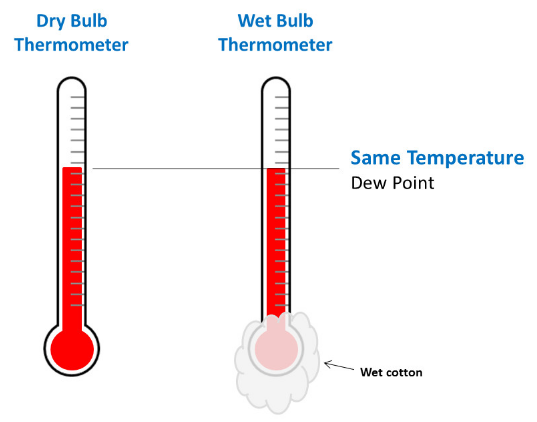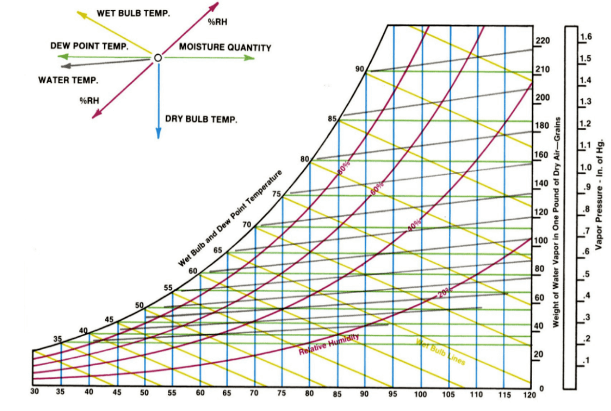What is humidity? / What is relative humidity? / What is specific humidity? / What is dry bulb temperature? / What is wet bulb temperature? / What is dew point?
Humidity:
Humidity is the amount of water vapour present in the air.

Relative humidity:
Relative humidity is the percentage of the total amount of water vapour present at a temperature and the maximum amount of water vapour that can be carried at the same temperature by the air.

Specific humidity:
Specific humidity is the percentage of the total mass of water vapour by the total amount of dry air.

Dry Bulb temp:
The dry-bulb temperature (DBT) is the temperature of air measured by a thermometer freely exposed to the air.

Wet bulb temp:
The wet-bulb temperature is the temperature read by a thermometer covered in water-soaked cloth over which air is passed. At 100% relative humidity, the wet-bulb temperature is equal to the air temperature and it is lower at lower humidity.
Dew point:
The dew point is the temperature to which air must be cooled to become saturated with water vapour. Where further cooled, the airborne water vapour will condense to form liquid water. When air cools to its dew point through contact with a surface that is colder than the air, water will condense on the surface.
For example; a coca cola bottle at -23℃ in the fridge. when this bottle goes out from the fridge and comes in the surrounding temperature of 30℃. Outside the bottle’s surroundings air makes a layer and releases the temperature and air water vapour becomes water droplets outside the bottle’s surface.

Psychrometric chart:
The psychrometric chart is a graphical representation of the thermodynamic properties of air, such as temperature, relative humidity, and specific volume, which are important factors in maintaining a comfortable and healthy indoor environment. By using a psychrometric chart, ship engineers and crew members can analyse and optimise the performance of the ship’s HVAC systems, such as the air handlers, chillers, and ductwork, to ensure that they are operating efficiently and providing the desired level of indoor air quality.

In the psychrometric chart, we can find the real dew point of the air with the help of dry bulb temperature and wet bulb temperature cutting point. The dew point is always a horizontal line. From the cutting point of dry bulb temperature and wet bulb temperature which relative humidity lines pass this is the percentage of relative humidity of this air.
Note:
If you want to learn more about this topic, we suggest checking out our Combo package with the given link https://www.merchantnavydecoded.com/courses/c/ . It’s a great way to dive deeper into the subject through video explanations. This package covers all the important details and presents them in an easy-to-understand format. Watching the videos will help you grasp the topic better and make learning more enjoyable. So, we highly recommend giving our Combo package a try to enhance your knowledge on the subject.
Disclaimer :- The opinions expressed in this article belong solely to the author and may not necessarily reflect those of Merchant Navy Decoded. We cannot guarantee the accuracy of the information provided and disclaim any responsibility for it. Data and visuals used are sourced from publicly available information and may not be authenticated by any regulatory body. Reviews and comments appearing on our blogs represent the opinions of individuals and do not necessarily reflect the views of Merchant Navy Decoded. We are not responsible for any loss or damage resulting from reliance on these reviews or comments.
Reproduction, copying, sharing, or use of the article or images in any form is strictly prohibited without prior permission from both the author and Merchant Navy Decoded.



